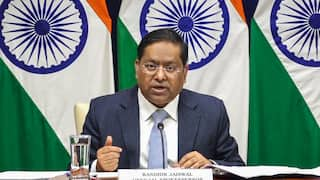Raman Raghav: Unmasking Serial Killer's Reign Of Terror In City Of Dreams
The streets of Mumbai were gripped by fear in the 1960s when a 'psycho killer' named Raman Raghav unleashed his reign of terror in the city, killing poor slum dwellers and those who slept on pavements.

Raman Raghav, a serial killer, haunted the streets of Mumbai in the 1960s. Known as the city of dreams, Mumbai (called Bombay back then) was a bustling metropolis undergoing significant changes and experiencing a unique blend of cultural, social, and economic developments. Among the hustle and bustle, it was the killings perpetrated by Raman Raghav that enveloped the city in horror. Raghav primarily targeted poor slum dwellers and individuals sleeping on footpaths. Initially, his motive behind the killings remained unknown.
Raghav's Early Life
Born in 1929, Raghav never received a formal education and developed a habit of stealing at an early age. He progressed to committing crimes such as robbery and murder. Prior to arriving in Mumbai, he confined his crimes to the city of Pune. After his arrival in Mumbai, Raghav became involved in various robbery incidents and faced several arrests. However, due to a lack of strong evidence against him, he was released on bail in all of these cases, as reported by Dainik Bhaskar.
Shocking Murders: Fear Grips Mumbai
Between 1965 and 1966, Raghav escalated the intensity of his crimes, which became increasingly heinous. During this period, Raghav carried out homicidal attacks on 19 individuals in East Mumbai, resulting in the deaths of nine. He also targeted around two dozen people sleeping near the Central Railway track.
The news of the attacks and murders of people sleeping on the streets of Mumbai sent shockwaves throughout the city. Even the police were baffled as to who was responsible for these brutal attacks on pavement dwellers in the dead of night.
Raghav employed a method of repeatedly hitting sleeping victims with blunt weapons such as a hammer. He also used a standard steel rod to viciously smash skulls and faces, according to Crime Wire. Raman is suspected of killing at least 40 people across the city.
Amidst the murders and the prevailing sense of fear among the residents of Mumbai due to Raghav's actions, rumours about the serial killer began to spread. People started to believe that the killer possessed supernatural abilities and could kill at will, as reported by The Crime Wire. Some claimed he could transform into any animal he chose, while others said they had seen him asleep under a tree near Aarey Colony, as reported by The Quint.
Panic Engulfs Mumbai
Despite the high number of victims, Raman Raghav managed to evade capture because those who survived his attacks had never seen him. The fear generated by Raghav had reached such mammoth proportions that the city of Mumbai went into lockdown, with residents too afraid to venture out after dark, as reported by The Crime Wire.
Raghav's reign of terror had engulfed the city to such an extent that fearful crowds began assaulting suspicious-looking homeless individuals and beggars, mistaking them for the killer.
Mumbai Police Digs into Raman Raghav’s Case
In 1968, a series of killings occurred in the western suburbs of the city, with all victims being slum-dwellers and destitute individuals living in decrepit hutments, lonely shanties, and pavements. The police were well aware that they were dealing with a serial killer.
That same year, the Mumbai Police appointed a new and young crime chief named Ramakant Kulkarni, who delved into the depths of the case. He meticulously studied the case, attempting to identify any patterns emerging from previous similar killings. His investigation led him to a series of homicides that had occurred two years prior, between 1965 and 1966, in Bombay's eastern suburbs, where 19 people had been attacked.
During the investigation, Kulkarni discovered that a homeless man named Raman Raghav had been detained by the police for questioning. Although the accusations were dropped and he was released, Ramakant Kulkarni was certain that Raman was somehow involved in these crimes.
Beginning Of The End For Raman Raghav
Finding a homeless serial killer in a massive city like Mumbai proved to be an arduous task for the police. With time running out and the body count increasing, a massive manhunt was launched across the city. The police searched every nook and corner, leaving no stone unturned in their pursuit of Raghav.
The suspected killer's photo was circulated to every member of the task force, and the press urged the public to provide any information that could assist in his capture.
Amidst the manhunt and search operations, the police patiently waited for Raman Raghav to make a mistake. Their wait finally ended when Raghav was spotted carrying a wet umbrella on a day when it wasn't raining in South Mumbai. Sub-Inspector Alex Fialho became suspicious.
He recalled, "I don't know what made me look at him. Those days, I used to carry photographs of the serial killer, Raman Raghav, in my shirt pocket. As I was waiting for a bus, I saw this well-built man in khaki shorts and a long blue bush shirt walking in my direction. I noticed he was carrying a wet umbrella. As it had not rained in South Bombay, I asked him where he was coming from, and he replied Malad (a place in the western suburbs where killings had occurred). This strengthened my doubt. He was also carrying half-rimmed spectacles and a thimble that belonged to a tailor who had been found killed in Malad a couple of days ago," as quoted by The Crime Wire.
Sub-Inspector Fialho arrested him on August 27, 1968, as reported by The Crime Wire, and Raghav was taken to the police station.
How Chicken Biryani Got Raghav Talking
In his book 'Footprints on the Sand of Crime,' Ramakant Kulkarni, who handled Raghav's case, dedicated an entire chapter to the serial killer. He mentioned that the real work had only just begun after Raghav's arrest.
During the investigation, Raghav maintained a studied silence. It was Kulkarni who managed to get him talking.
Anita Bhogle, daughter of Ramakant Kulkarni, said, "My father truly believed in understanding the psychology of both victims and accused in all his cases," as quoted by The Quint.
When asked if he wanted anything, Raghav mentioned 'murgh' (chicken). He then requested more food, hair oil, a mirror, and a comb. On Kulkarni's orders, all of his requests were granted, as reported by The Quint.
After eating and applying coconut oil to his body, Raghav glanced in the mirror for a few minutes before staring at the police officers and saying, "Now tell me, what do you want?"
Raghav Reveals Chilling Details And Evidence Of His Crimes
In his book, Kulkarni mentioned that once all of Raghav's wishes were fulfilled, he asked for further demands to be met before providing details about the murders he had committed.
"Well, I shall tell you all about them. Get a vehicle, an armed guard, and two witnesses. The law requires that. And I shall show you the iron akada I used to commit the murders, knives, and other things which I have hidden in the bushes at Aarey Colony," an excerpt from Kulkarni's book as quoted by The Quint.
True to his word, Raghav led them to a blood-stained iron fulcrum hidden in the bushes. He also produced knives, a screwdriver, and the 'loot' from his murders, which included a coloured napkin, a torch, an umbrella, and a stove, among other items.
Trial & Punishment
Raghav agreed to provide a detailed confession in front of the magistrate. Following his confession, he was initially sentenced to be hanged, but later the sentence was commuted to life imprisonment due to his diagnosed mental condition of chronic paranoid schizophrenia.
Raghav was lodged at Yerwada Jail in Pune, and he died in 1995 due to kidney failure.
The Inner 'Voice Of Shiva'
Dr Anand Patkar, a psychiatrist who spent 80 minutes with Raghav on August 5, 1969, stated that Raghav exhibited homicidal tendencies due to chronic paranoid schizophrenia, as reported by The Indian Express.
Dr Patkar wrote to the court, "Over a number of years, the suspicious tendencies get exaggerated, organized, and systematized, and the patient tends to build up a suspicious world of his own," as quoted by The Indian Express.
Raghav confessed to the doctor that he wanted to kill a waiter simply because he had adulterated his tea. In most cases, he admitted to having killed people after receiving a command from a "Duniya wireless" inside his head. He referred to these "wireless" messages, which he called "kanoon," as a "buzzing command" inside his head, as reported by The Indian Express.
Dr Patkar's son, Sachin, a consultant psychiatrist, meticulously studied his father's notes on Raghav's "command hallucinations." "My father spoke to him for over an hour and made a diagnosis on the first day itself. The inner voice Raghav believed was of Shiva," The Indian Express reported.
The Bombay High Court, in its order on August 4, 1987, observed, "The accused has thought, or has suffered from a delusion, that he was acting under the command of a law which was higher than the law of the land. He also regarded that it was obligatory upon him to follow the kanoon which told him to kill persons."






































